9.3 Problems Associated with Groundwater
Describe problems with groundwater that result from human activities.
Groundwater is essential for human needs, particularly in arid regions, where most or all water used by people comes from the ground. Heavy reliance on groundwater can create conflict among neighboring communities drawing from the same aquifer. There are two major problems associated with human use of groundwater resources: (1) withdrawal of groundwater faster than it is replenished and (2) pollution of groundwater.
Too Much Too Fast: Groundwater Overdraft and Mining
The height of the water table in an unconfined aquifer is the result of a balance between groundwater recharge (inputs) and groundwater discharge (outputs). Human activities can disrupt this hydrologic balance by groundwater overdraft and groundwater mining.
Groundwater Overdraft
Groundwater overdraft is the removal of water from an aquifer faster than the aquifer is recharged at the site of a well. Groundwater overdraft often forms a cone of depression: a cone-
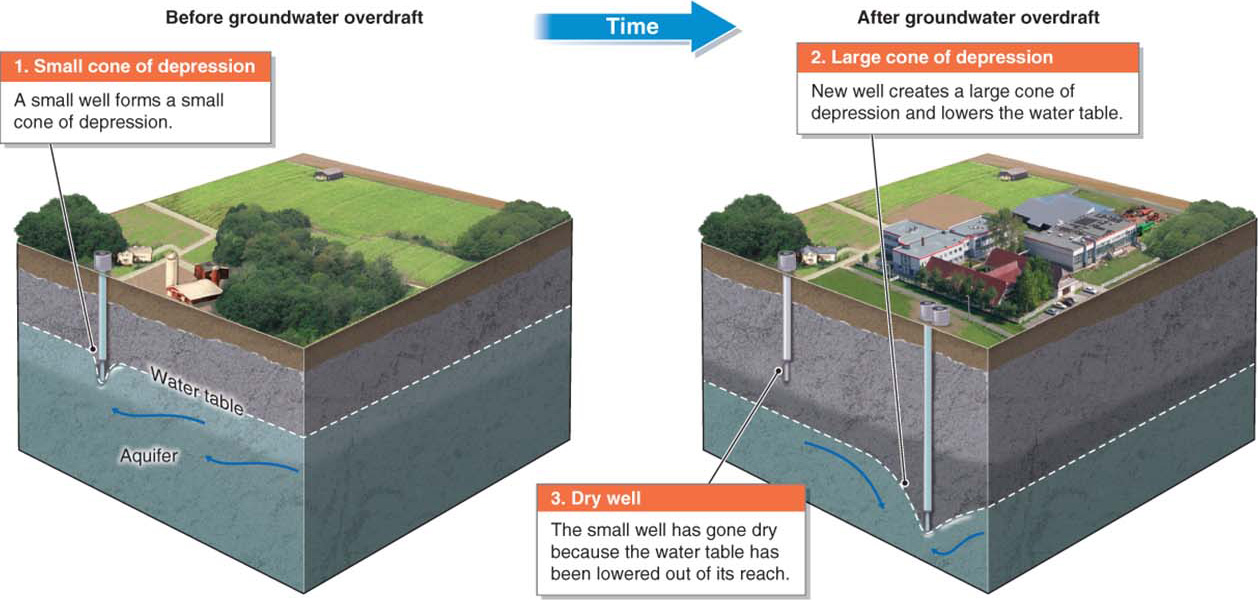
groundwater overdraft
Withdrawal of water from an aquifer faster than the aquifer is recharged at the site of a well.
cone of depression
The cone-
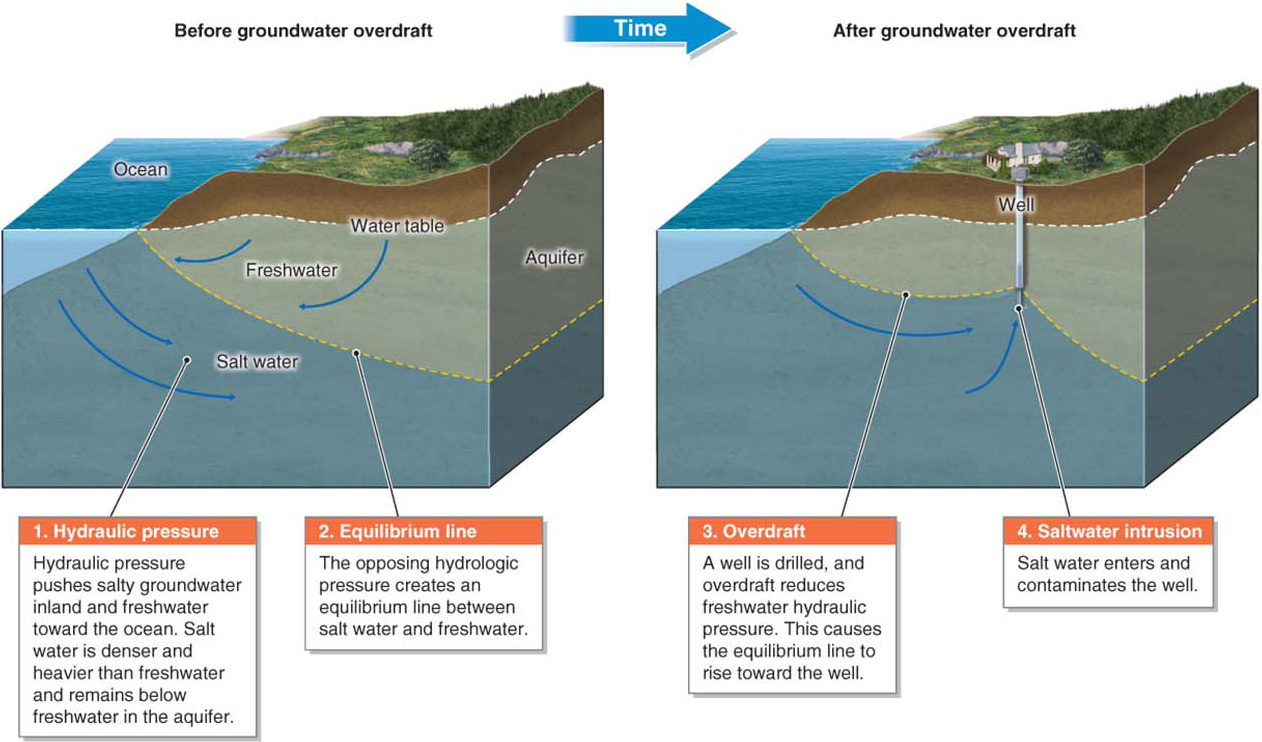
Groundwater overdraft can result in several additional problems, including a lowered water table at other wells, contamination of wells by salt water, and land subsidence.
Lowered water table: If neighboring wells are not deep, the cone of depression can lower the water table and cause them to go dry (see Figure 9.27).
Saltwater intrusion: In coastal regions, a freshwater aquifer may lie on top of salty groundwater. Groundwater overdraft may cause the salty water to migrate higher in the aquifer and contaminate wells. This process is called saltwater intrusion (Figure 9.28). Saltwater contamination of a well is permanent and irreversible.
saltwater intrusion
The contamination of a well by salt water as a result of groundwater overdraft.
Page 313Land subsidence: The pressure of the water in the pores of sediments keeps sediment particles apart while the ground is saturated. When water is removed, these pores can collapse under the weight of the sediments. When this happens, the elevation of the land surface drops as the sediments are compacted (Figure 9.29A) In most cases, once the pores in the aquifer collapse, they can no longer hold water, and the aquifer is lost permanently. Near Mendota, in the San Joaquin Valley, California, the land elevation has dropped more than 8.5 m (28 ft) due to groundwater overdraft. In some cases of land subsidence, large surface fissures (or cracks) can open up (Figure 9.29B).
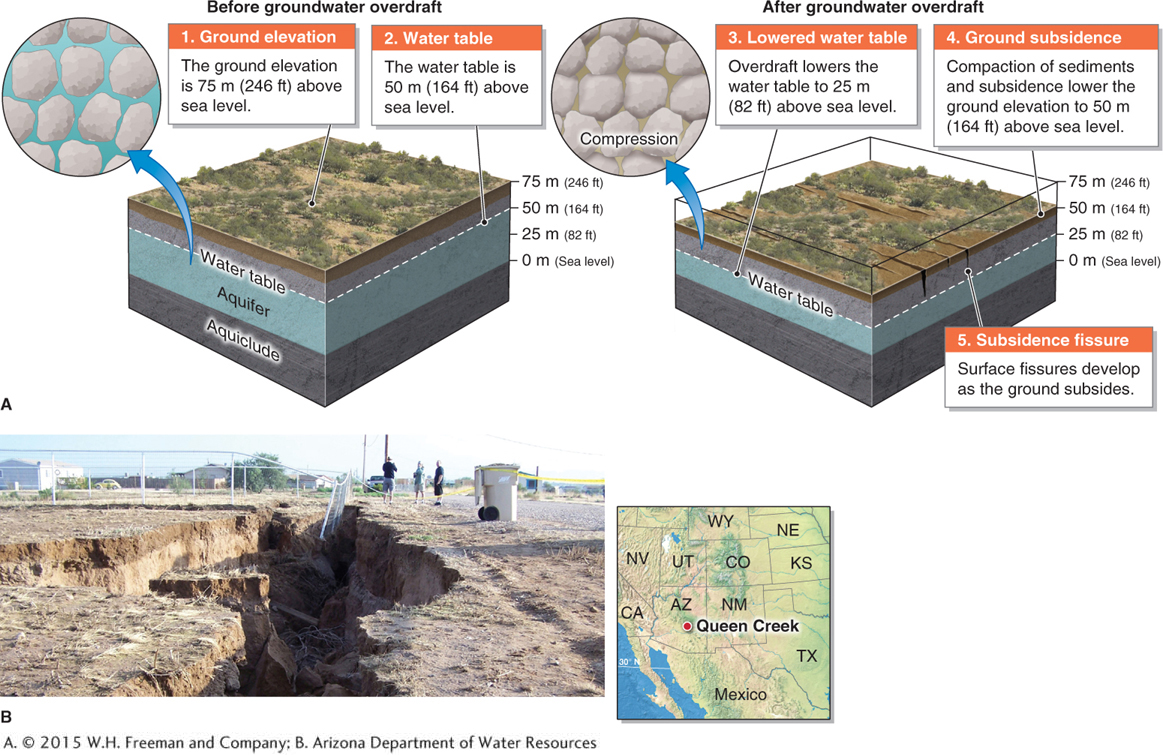
Groundwater Mining
Groundwater mining is the process of extracting groundwater from areas where there is little to no groundwater recharge. In areas where there is no recharge, once groundwater has been mined, it is gone permanently.
groundwater mining
The process of extracting groundwater where there is little to no groundwater recharge.
North America’s largest aquifer is the Ogallala Aquifer (also called the High Plains Aquifer), which lies beneath the Great Plains (Figure 9.30A). About 200,000 water wells tap into the Ogallala Aquifer. Most of them are connected to center-
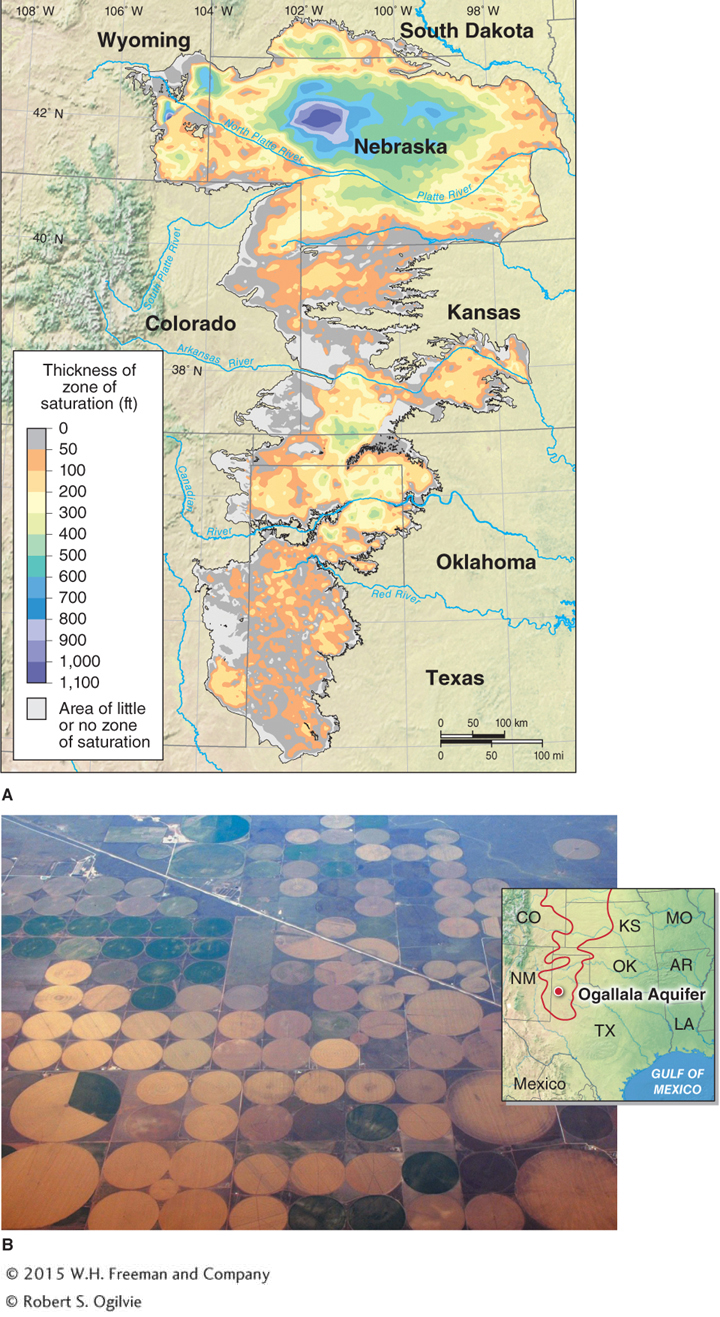
The water in the Ogallala is fossil groundwater: water that entered the aquifer long ago and is no longer being replenished. Most of it came from the now-
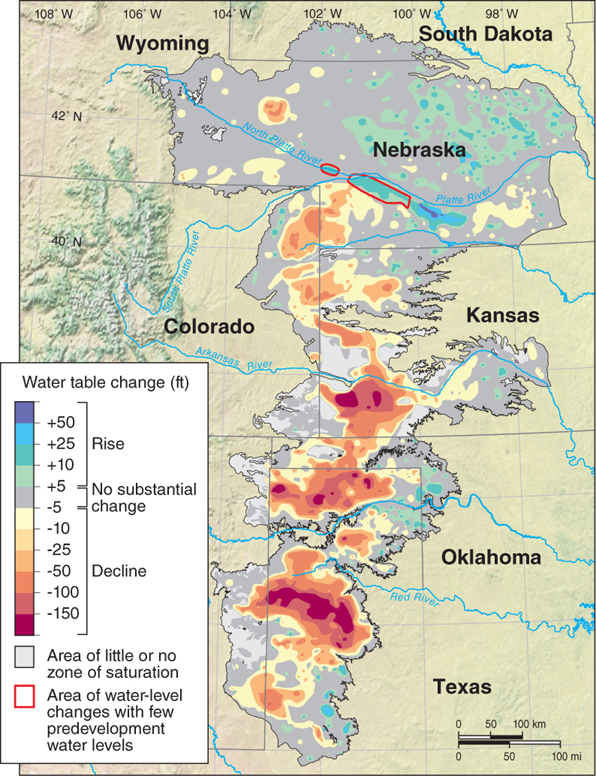
fossil groundwater
Water that entered an aquifer long ago and is no longer being replenished.
Aquifers in arid regions, where there are no permanent surface water bodies, are always composed of fossil groundwater. Many countries face looming problems with the loss of groundwater, including China, India, Pakistan, and most countries in the Middle East. About one-
Groundwater Pollution
Common sources of groundwater pollution include leaks from landfills (or dumps), septic systems, and gas station tanks; agricultural chemicals; animal sewage from factory farms; and mining activities. The process of mining natural gas from shale rock is also linked to groundwater pollution (see Section 13.5).
In some areas, toxic chemicals are (or were) intentionally dumped on the ground or injected into aquifers from wells to dispose of them cheaply. In the 1950s and 1960s, the large utility company Pacific Gas and Electric (PG&E) dumped hexavalent chromium into a collecting pool. From there, the chemical seeped into the ground and migrated several miles through the aquifer. The wells in nearby Hinkley, California, gradually became contaminated, and rates of various types of cancers skyrocketed in the small town. Many of the residents became ill and died. Although PG&E denied wrongdoing, the company was held accountable in court because of the efforts of the environmental activist Erin Brockovich. Environmental regulations are now in place to stop (or at least reduce) such practices.
Picture This
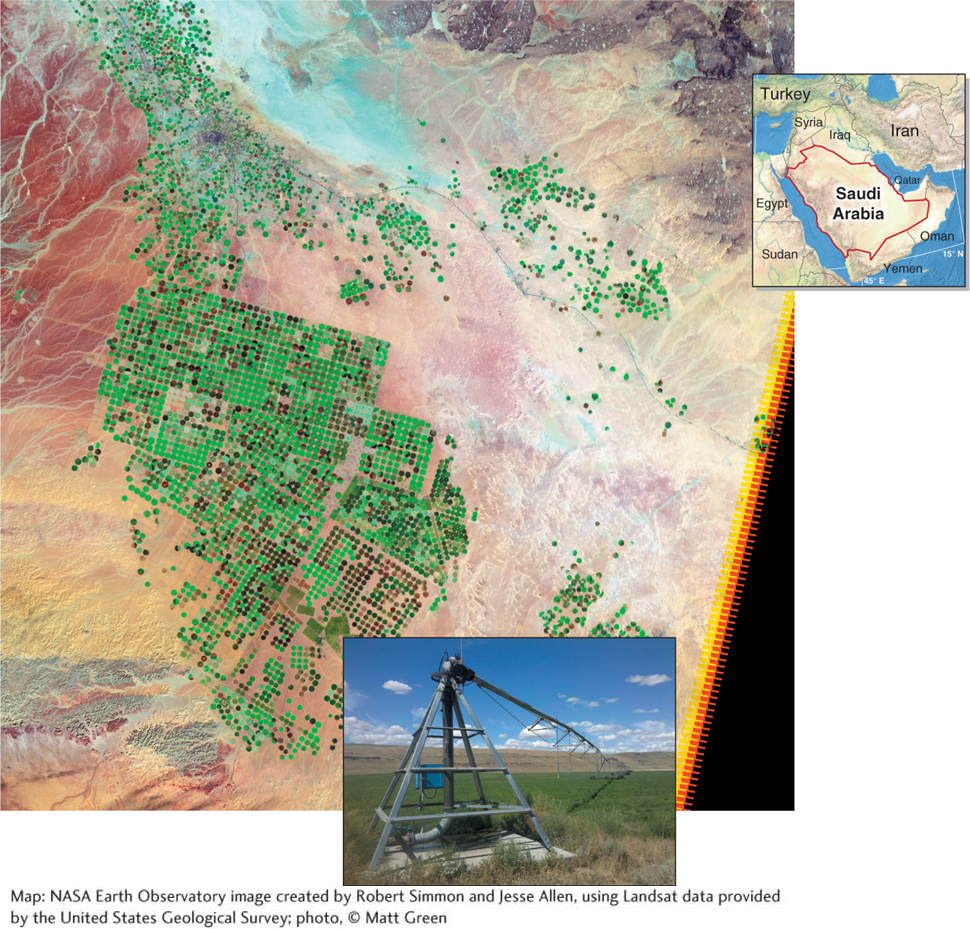
Groundwater Mining
This Landsat satellite image acquired in January 2012 shows center-
The green agricultural fields visible in the desert indicate that groundwater is being mined. At the center of each green circle is a well pipe and a diesel pump that pulls water up from the aquifer below. Here, water is pumped from as deep as 1 km (0.6 mi) beneath the surface. The water moves through a tubular arm called a gantry that stretches across the circle’s radius (inset). The gantry slowly sweeps around the field. The diameter of each circle is about 1 km (0. 6 mi).
Consider This
Question 9.6
Why do circular agricultural fields always indicate that groundwater is being used?
Question 9.7
Why is farming in the Arabian Desert unsustainable?
Once pollutants have entered an aquifer, they disperse as a contaminant plume: a cloud of pollution that migrates through the aquifer away from its source (Figure 9.32). Any pollutants, natural or anthropogenic, that enter the aquifer stay there for centuries or longer. Therefore, the loss of an aquifer through groundwater pollution is, in most cases, permanent.

contaminant plume
The cloud of pollution that migrates through an aquifer away from its source.
Various techniques for cleaning up polluted groundwater have been tried. These techniques include the use of bacteria to digest the contaminants and the use of chemicals to react with the contaminants, changing them into other, less harmful chemicals. The process of cleaning a contaminated aquifer is called groundwater remediation (Figure 9.33). In most instances, however, the best option becomes closing contaminated wells and stopping the “upstream” sources of contaminants.

groundwater remediation
The process of cleaning a contaminated aquifer.
